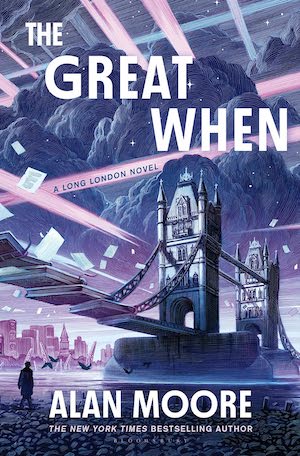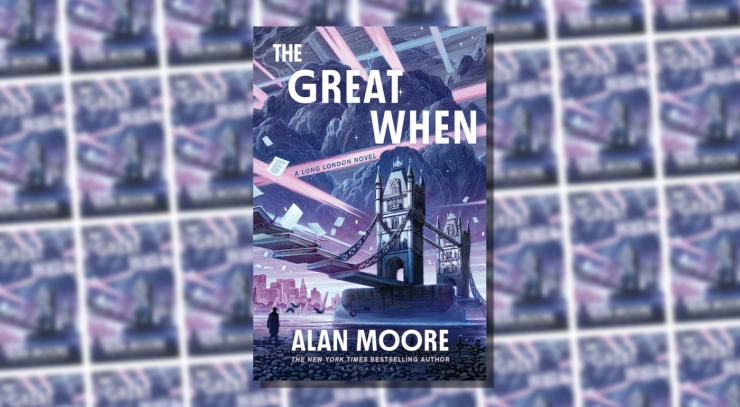1949. London, and eighteen-year-old Dennis Knuckleyard, are still recovering from the Blitz.
After the death of his mother, he was taken in by the bad-tempered and bitter Coffin Ada, who runs her bookshop with such fury that she routinely throws customers into the street and tears up the books they try to haggle for. His prospects are just as miserable as his landlady: He can’t talk to women, which he demonstrates in a frankly disastrous encounter that leaves “his every cell cringing from its neighbors in embarrassment.” He lives in envy of his (only) friends, a glum journalist named Tolerable John and a lively lawyer named Clive who both seem too good for him.
Then he’s sent out to pick up some spiritual esoterica written by Arthur Machen from a reclusive bookseller—and hidden in the box is a battered book not by Machen at all, but by the Reverend Thomas Hampole: A London Walk: Meditations in the Streets of the Metropolis. Only when he brings it back to Ada does she realize that this book is dangerous. Very, very dangerous.
The first problem is, the Reverend Thomas Hampole is fictional, and so is his book. The copy Dennis is (rather nervously, now) holding onto comes from another London, the Great When, a glittering, supernatural version of the city that exists in the same place. When Moore gets philosophical, his characters talk about the Great When as the Platonic London, a place where concepts such as Crime, Fashion, or the Beauty of Riots are manifested as enormous figures and which serves as the unseen driver of the physical London’s fate: When it prospers, London prospers; when it suffers, London suffers.
The second problem is that this book will get Dennis killed. The heads of the Great When—momentous figures from London history like Oliver Cromwell or Anne Boleyn—are desperate to prevent any breach that might expose their city to the unknowing public. And London’s most notorious gangster, Jack Spot, wants his hands on it too: He’s heard about the way the Great When’s capriciousness ripples into London, and he wants a bargaining chip to make sure the winds blow in his direction.
When I started The Great When, I expected it to follow the path of standard “otherworld” fantasy novels—that Dennis, our hapless protagonist, would be pulled into the world of this other London and spend the bulk of the book discovering it. But I was surprised to see that the book didn’t really follow that track: While Dennis certainly has his chance to wander around the Great When, he spends most of his time in the physical London. The Great When is simply too overwhelming for normal humans to experience for more than a few hours, rife as it is with scurrying bottle caps, living newspapers, and contemptuous cats.
Buy the Book


The Great When
Instead, the magical and supernatural characters that populate the story are usually found in physical London, helping Dennis (who usually needs it). My favorite is Blincoe, a tall, gravelly, good-natured fruit-seller who also happens to be made entirely of wood. Dennis first spots him loitering outside the bookseller’s, keeping an eye out for his contraband book; later, he serves as Dennis’s liaison to the leaders of the Great When and helps him deal with his gangster problem. Knives and guns, it turns out, aren’t very effective against a man whose body is solid oak.
My experience with Alan Moore is through comics—Watchmen and V for Vendetta, rather than his literary work—and I was delighted to see that much of The Great When feels like a comic, like Moore is able to conjure up the vibrancy and dynamism of comic panels even in a text-only medium.
I’ve never seen sound effects done as lovingly (and as visually) in novels as they are here: when a young Dennis is sheltering from the Blitz, his thoughts are broken up by the BOOMBOOMBOOMBOOMBOOM of bombs falling; Coffin Ada litters her dialogue with “cough cough cough cough”, spelled out; and there’s my favorite moment, when Dennis is struggling to be heard over a passing salesman:
“Sorry love, I might not WHELKS! the right address. I’m here from Ada Benson’s bookshop LOVELY WHELKS! in Shoreditch, looking for a Mr. Harrison. She’d heard he’d got some Arthur GET YOUR WHELKS HERE! that he wanted rid of.”
Every time I read one of those sections, it felt as though Moore was dictating a comic to me, the sound effects that made the world feel alive. His visual descriptions are similarly evocative: When Dennis catches sight of himself in a mirror, he’s described as “a thing made out of string with lumpy knots to represent his knees and elbows… the short back and sides that left a bristling chestnut lawn atop his shaved suede skull made him look like a wilted thistle.” Reading that, I could see Dennis exactly as he’d appear in full ink and color, his lankiness exaggerated and his expression gloomy.
One thing that I did find lacking as I read, however, was the role of women in the novel. Simply put, there aren’t many women and they don’t do much. Aside from Coffin Ada, who kicks Dennis out of her bookshop as soon as she realizes Thomas Hampole’s book is dangerous, the only other female character is Grace Shilling, a young, red-haired prostitute who Dennis first encounters reading about ghosts. Aside from letting him sleep on her couch because he looks so pathetic, her main role seems to be… looking pretty. She’s held hostage by Jack Spot so that Dennis will help him get an audience in the Great When—and her predicament becomes the reason many of Dennis’ allies agree to assist him, so that they might rescue the innocent young woman. Otherwise, she hardly interacts with the magical aspects of the story, and is content with Dennis refusing to tell her anything for her own safety, even after she’s dragged into Spot’s machinations.
The Bechdel test—that two women have a conversation with one another, not about a man—can be reductive, and doesn’t always serve as a useful descriptor of how a work treats women, but I was frustrated that The Great When doesn’t even pass that: There are so few women throughout the whole work that no two of them ever interact. While The Great When is not without its social commentary, with multiple characters going on extended soliloquies about the state of Britain and British psychology after the war, none of that serves as a vessel to explore women’s status in post-war Britain.
In the end, though, The Great When is only the first installment in the five-book series Long London from Moore—and I’m captivated enough by his language and imagery that I’m definitely coming back for the next.
The Great When is published by Bloomsbury.










